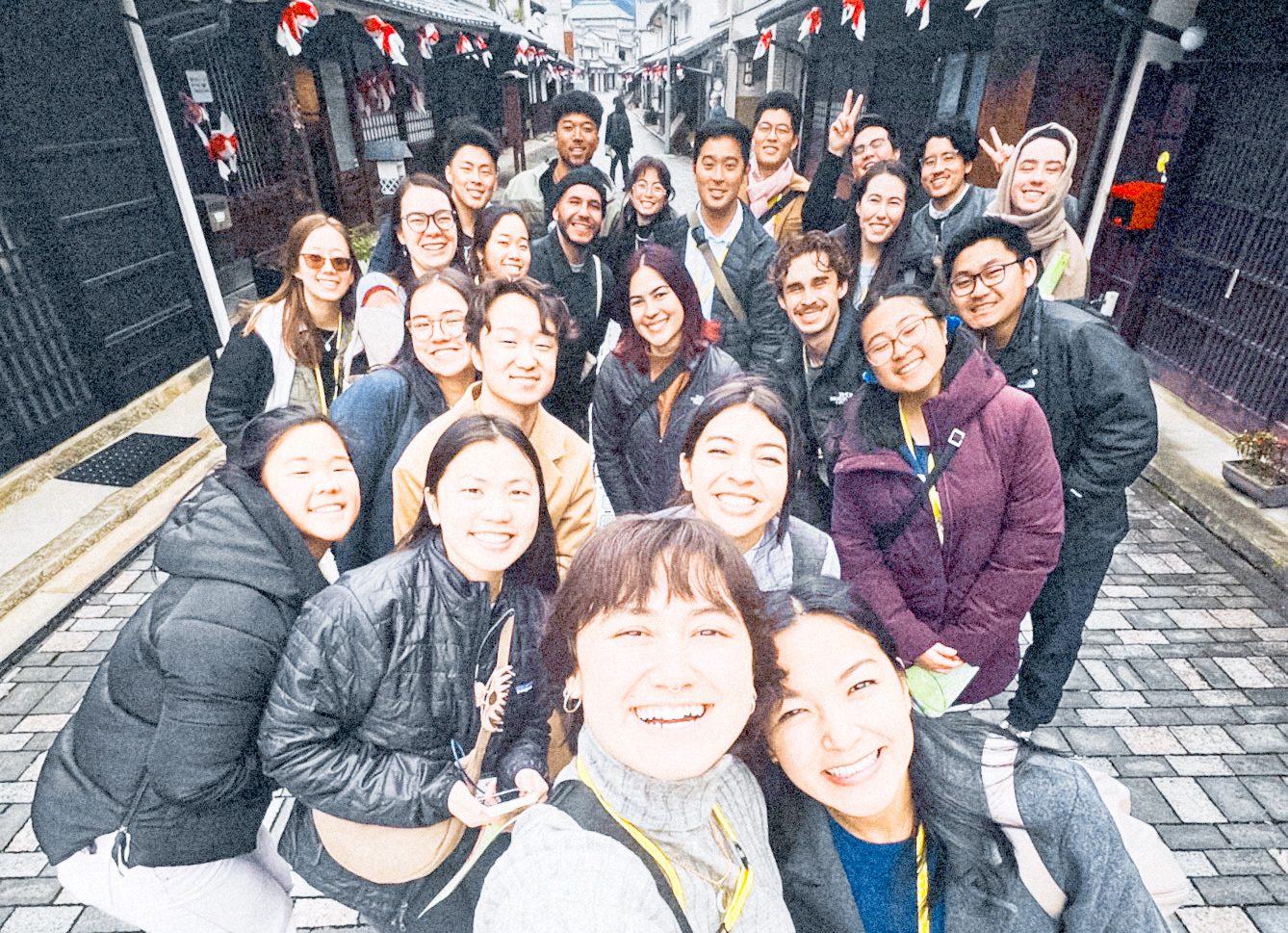Kakehashi 2024 participants walk the white-walled streets of Yanai, famous for its picturesque merchant homes, all of which are decorated with
red paper goldfish lanterns. (Photo: Courtesy of Noah Haramoto/Zaria Guignard)
Nikkei from across the U.S. journey to Japan to develop and strengthen
their connections to Japanese culture.
By Kakehashi 2024 Participants
In January, 71 Nikkei and three chaperones traveled from the U.S. to Japan to participate in Kakehashi 2024, where they visited numerous historical and educational sites, experienced traditional and cultural activities and participated in lectures and workshops with the goal of building a mutual understanding between the U.S. and Japan for future friendship and cooperation.
Divided into three groups, participants began their trip in Tokyo and then traveled on to Hiroshima and Okinawa, depending on their group destination assignment. This “once-in-a-lifetime dream trip” to Japan was made possible thanks to coordination by the JACL and the Japan International Cooperation Center (JICE) and supported by funding from the Japan Ministry of Foreign Affairs.
Following are personal trip reflections from several of this year’s participants.
Ashley Bucher, Group B Chaperone
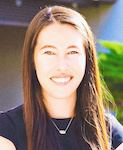
Ashley Bucher
Anyone identifying as Japanese living outside of Japan has probably felt some degree of disconnectedness. Whether it’s longing for the comforts of home, grieving loss of culture due to your family’s assimilation or feeling like you don’t fit in where you live, separation from your family’s homeland can affect your sense of self and place in the world. Trying to navigate this Nikkei diaspora by yourself can be especially lonely. Thankfully, being in community with people who have similar experiences can provide solace, strength and space to feel at home in who you are.
Through the Kakehashi Project, our mighty group came together in Japan and fostered community in just nine short days. We were a diverse bunch, hailing from New York to Hawaii; identifying as mixed Japanese American, full Japanese American and Japanese American by adoption; ranging from freshmen in college to young professionals in the midst of our 20s. With open hearts and minds, we set out on this once-in-a-lifetime experience to discover as much as we could about Japan, ourselves and each other.
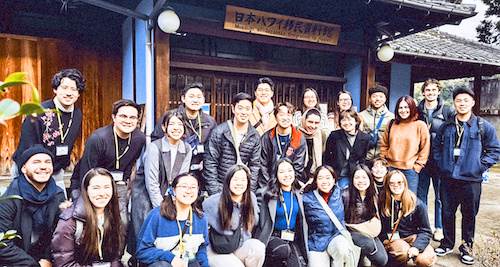
Group B at the Museum of Japanese Emigration to Hawaii (Photo: Courtesy of Ashley Bucher)
After a couple days in Tokyo, Group B flew to Iwakuni, a small city in Yamaguchi prefecture. We wandered the drizzly streets in search of okonomiyaki (happy to report we were successful), and some of us got up early the next day to catch a glimpse of the famed Kintaikyo Bridge at dusk.
As we made our way to the Museum of Japanese Emigration to Hawaii, we were welcomed with sweeping views of rice fields, mountains and the Seto Inland Sea. The museum is located in the beautiful town and island of Suō-Ōshima, a laid-back spot also known as the Hawaii of Setouchi and famous for its mikan, a type of citrus fruit.
Once at the museum, we took in the troubling past of Japanese emigration in the late 1800s and Suō-Ōshima’s personal ties to Hawaii. Generous museum staff also helped some of us use their well-kept database to find records of family who came to Hawaii from Japan.
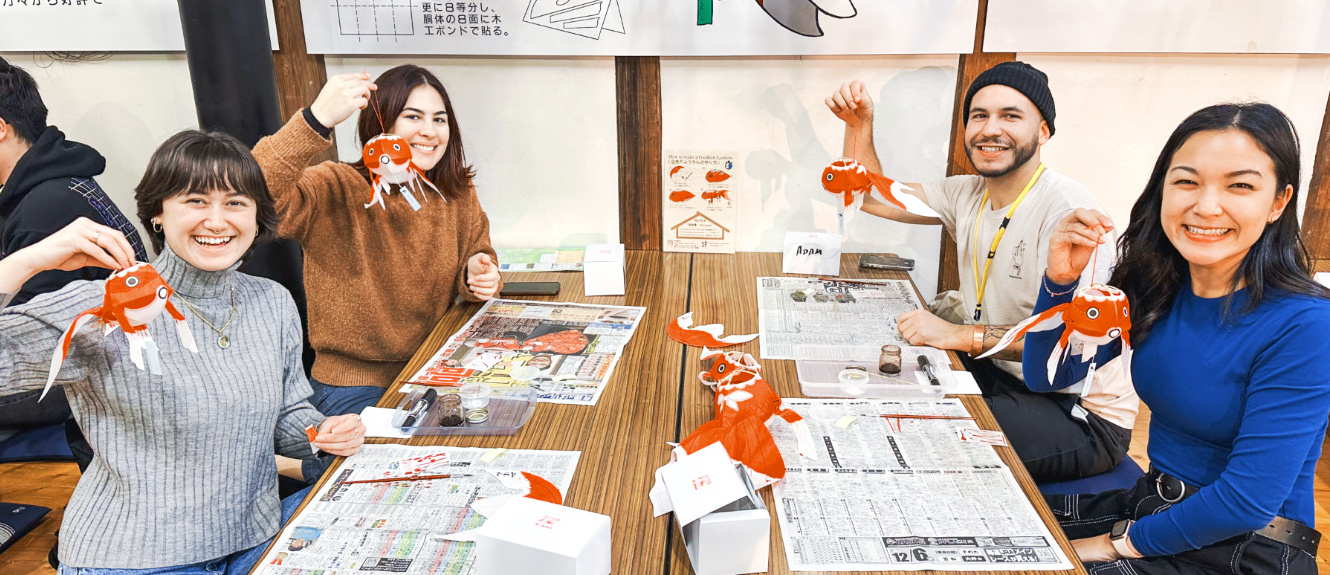
Crafting goldfish lanterns in Yanai are (from left) Zaria Guignard, April Gore, Adam Bittner and Shari Nishijima. (Photo: Courtesy of Ashley Bucher)
Later that afternoon, we traveled to the white-walled streets of Yanai for goldfish lantern crafting. This charming historical town is dotted with hundreds of delicate goldfish lanterns, originally crafted by merchants over 150 years ago to entertain children. Inside a stunning white and wooden building known as Yanai Nishikura, gracious volunteers guided us in painting and gluing together our very own goldfish, complete with wide eyes and flowing tails.
Next door, we stumbled upon Sagawa Soy Sauce Factory, where we were kindly given a tour. The factory has been in the shoyu business for nearly 200 years and ferments soy sauce in enormous wooden vests. The intense, umami aroma of shoyu enticed us to indulge in omiyage to bring home and some shoyu ice cream for the road.
That evening, our participants set off to their respective host families’ homes all around Suō-Ōshima. I had the chance to visit a few of them the next day as they experienced Suō-Ōshima life — harvesting mikan, learning the art of bento, frying up okonomiyaki. The families’ hospitality was unlike anything I’ve ever seen as I watched them curate intentional experiences and welcome participants into their lives with open arms.
They were thoughtful toward us visitors, too, offering mikan to try, giving a tour of the 100-year-old home they restored, setting up mats to sit on and passing out homemade mikan jelly. After a quick two days, we said our tearful goodbyes and promised to see each other again, waving to the families from the bus until they were out of sight.
Our last stop before we reunited with the rest of our cohort was Hiroshima. We walked through the Hiroshima Peace Memorial Museum as well as the Hiroshima Peace Memorial Park, taking in the horrors and devastation of the atomic bomb on Aug. 6, 1945. Later that night, a few of us came back to the park to see it lit differently and reflect more.
Looking back, I am overflowing with gratitude for this rare opportunity to be in community with so many young Japanese Americans. Countless vulnerable conversations were had about our family histories, mixed identities, cultures and traditions and so much more. I’m honored to have been welcomed by Group B to join in these experiences and have played a small, small part in their trip. Thank you to Cheyenne Cheng, Bridget Keaveney and David Inoue, and to our dedicated JICE coordinators Mayumi Iida and Keisuke Matsuzawa for making any of this possible.
どうもありがとうございます !
Spencer Uemura, Group C Chaperone
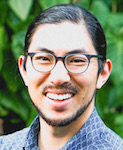
Spencer Uemura
In mid-January, I had a taste of what I call “Japanese American heaven.” Traveling along with about 70 young adult Nikkei from across the country, I had the unique privilege of supervising 24 of them as we developed and strengthened connections to Japanese culture and between ourselves as Japanese Americans. For one very full week, our itinerary was as jam-packed with learning opportunities as our suitcases would be filled with souvenirs at the end of the trip.
Our first days were in Tokyo, where we visited the Tokyo National Museum and had a few brief meetings with government officials. Our next few days were spent in Yamaguchi prefecture on the island of Suō-Ōshima. Not surprisingly, it also has close ties to Hawaii through the large proportion of residents who immigrated there around the turn of the 20th century.
Our group visited the local Museum of Japanese Immigration to Hawaii, and kind volunteers pored through records to help many of us learn new information about our ancestors who immigrated to Hawaii. Of course, a major highlight for the participants was a short homestay experience on Suō-Ōshima, which involved cooking (and eating!) local foods, sightseeing and talking about Japanese and Japanese American culture. After leaving Yamaguchi prefecture, we had a short visit to Hiroshima to visit the Hiroshima Peace Museum before spending our final days in Tokyo.
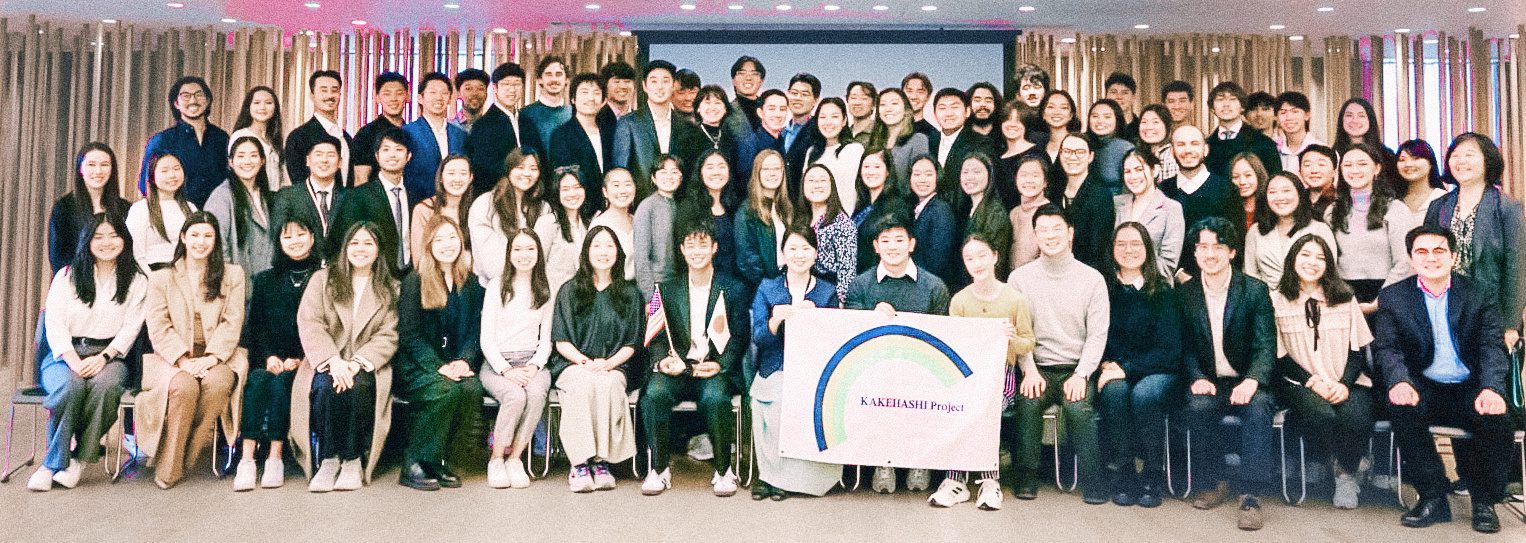
The 2024 Kakehashi participants and chaperones unite for a final photo in Tokyo before departing back to the U.S. (Photo: Courtesy of JICE)
While the places we visited and the things we did were impactful on their own, for me the power of the trip was in the people I traveled with. Multiple times a day, I’d take a look around and marvel at the rare experience of being in Japan with dozens of other Nikkei. This was indeed my “Japanese American heaven,” being in our heritage country, having conversations about cultural and personal identity and making connections with every kind of Nikkei across the tapestry that is the diverse experience of being Japanese American.
We represented different regional JA experiences in the U.S., multiethnic and monoethnic, across all levels of language knowledge, those with dual citizenship as well as first-time travelers to Japan and with a diversity in gender, sex and ability.
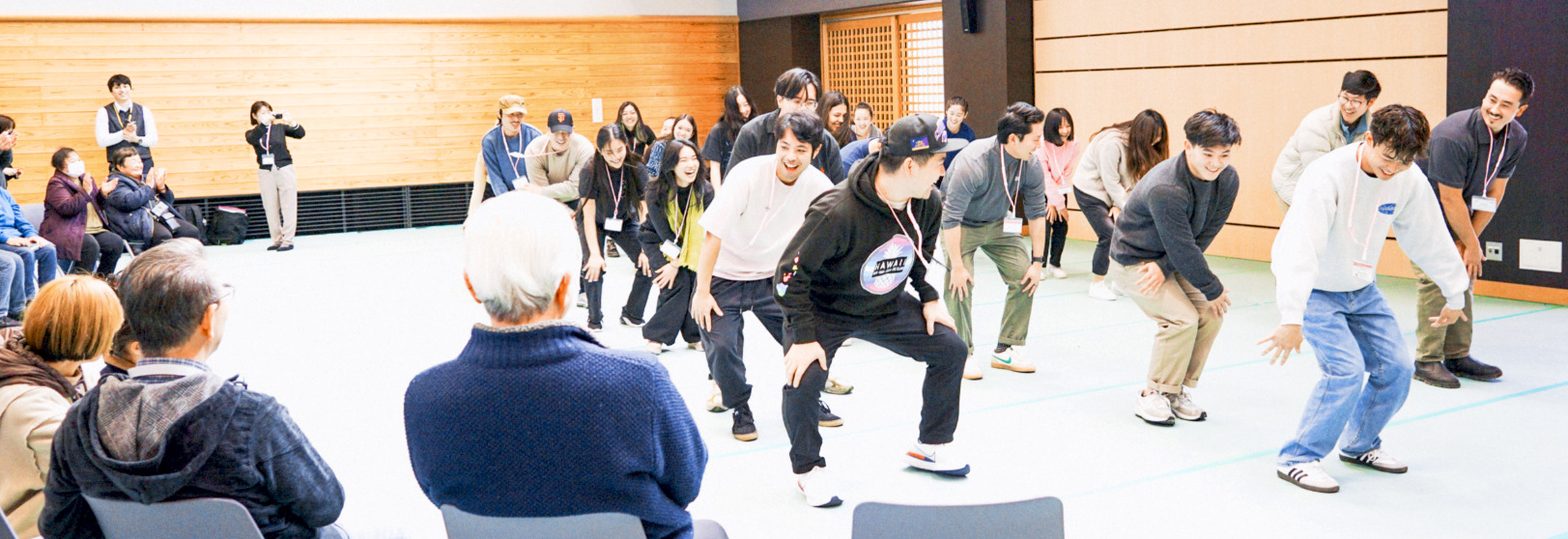
Group C shares some American dances as a thank you to their host families in Suō-Ōshima. (Photo: Courtesy of Spencer Uemura)
Through years of my own personal healing journey and the invaluable guidance of wise Japanese American mentors, I’ve come to embrace the belief that there is no wrong way to be Nikkei. Contrary to the shame many of us may feel for “not being Japanese enough,” each individual in our community brings a unique perspective and contribution to our shared heritage.
We all belong. All of our experiences, our identities, our aspirations paint a picture of the long history that we have in America and the resilience required to make a place for ourselves in the past and into the future. And if the folks in my group were any indication, our community is in good hands moving forward.
It’s difficult to describe the incredible impression these young adults had on me. In our group, there was so much evidence of thoughtfulness, determination, community investment, curiosity, kindness and humor. Within a short period of time, we had gone from strangers to a small community of friends, a microcosm of the support and care that thrives in many Japanese American spaces.
One repeated theme that arose in conversations about JA community involvement were the barriers to leadership, the organizational hierarchies that have dampened their voices. There were stories of unacknowledged feedback even when it had been requested and a feeling of dismissal from some of the groups that aim to represent them. Sometimes in the veneration of age and experience, we may miss the wisdom coming from all around. And that is a loss for all.
A few weeks ago, I watched “What the Constitution Means to Me” at the Portland Center Stage. Through anecdotes, personal stories and historical context, the play explored how young people engage with and interpret the Constitution, as well as their role in shaping the future of the country. The main character offers an admonishment toward the end of the play, as paraphrased below. May it serve as a reminder to keep our ears open and listen to the younger voices. May we take heed especially as they draw necessary attention to things like climate change, gun violence prevention and the ongoing humanitarian crisis in Gaza.
“Young people are not waiting for us to pave the way for them. They are out there, shining a light on the issues that matter, and it’s up to us to follow their lead and support them in creating a better future for all.”
Julie Abo, Group A Chaperone
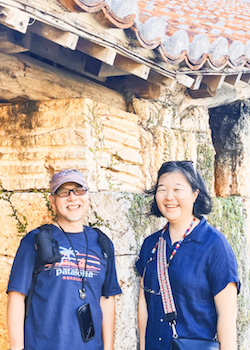
Julie Abo with Erito Uchiyama, director of the Kyushu Office for JICE, at the pottery kilns in Yomitan, Okinawa (Photo: Courtesy of Julie Abo)
I was elated when I opened my email to find that I was selected to be a chaperone for the 2024 Kakehashi trip to Okinawa. Over the past few years, I had learned pieces of culture and history about Okinawa/Uchina and recently discovered my Ryukyu Kingdom DNA. There were also nine participants with family connections to Okinawa. I felt the excitement of self-discovery along with them.
We were under the great care of Erito Uchiyama, Japan International Cooperation Center Kyushu Office director, and Miki Yanase, who was our awesome guide and translator. Airi Goto was our trusted travel agent. They were our cultural ambassadors as we traveled from Tokyo to Naha and Kin, Okinawa.
The strong and distinct Okinawan culture was reflected in some of the historical and educational sites such as Kyuzo Toyama Memorial Museum (emigration history), where we learned about the forced incorporation of the Ryukyu Kingdom into Japan after 1879 and the sudden economic decline and subsequent push by Kyuzo Toyama to allow Okinawans to emigrate to Hawaii. There were harsh working conditions in Hawaii, but many stayed.
We traveled to Kin town and greeted the mayor and his staff, who were very welcoming. Another highlight of the trip was an exciting exchange with University of the Ryukyus students, where the participants were put into groups and discussed immigration, identity, food and culture.
They formed fast friendships and found it hard to leave. The most memorable part of the trip was the homestay with local families who provided traditional and cultural activities such as harvesting sugar cane, playing the sanshin stringed instrument and making sweet mochi for three days and two nights.
At the closing in Tokyo, the participants gave a reflective group presentation about what they learned about Japan, Okinawa and their own identity. The resilience, openness and inclusionary culture of the Okinawan families inspired them. At the beginning of the trip, some may have felt some apprehension about their Japanese identity, others not, but this shared experience created a community that made them feel supported and acknowledged. Many of us hope to return to Japan and Okinawa. We are ready to learn more.
Allie Umemoto, Group B Participant
Before the Kakehashi trip, I had a strong sense of my Japanese American identity. My parents and grandparents taught me about the World War II incarceration camps, and when I was 8 years old, we visited Topaz, Utah, where my mother’s parents were incarcerated.
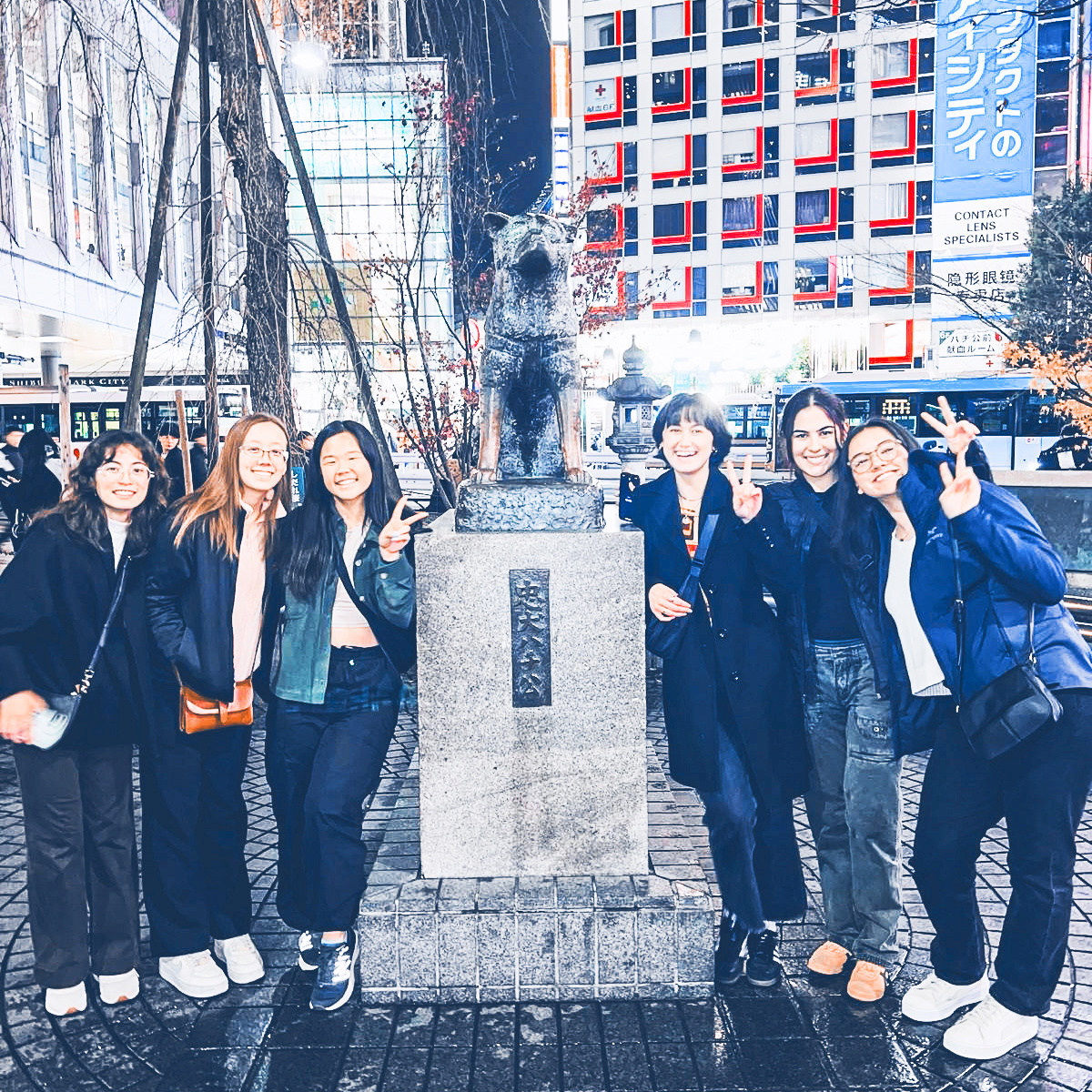
At the Hachiko statue in Shibuya Station are (from left) Alana Komatsu, Robin Dewis, Allie Umemoto, Zaria Guignard, April Gore and Amy Hattori. (Photo: Courtesy of Allie Umemoto)
I am immensely grateful for these strong Japanese American communities that raised me, but I also understand the history in which they were created. A history of intense discrimination, exclusion and hate that Japanese Americans experienced before, during and after the war.
These communities allowed me to develop a strong sense of a Japanese American identity largely defined by the incarceration experience, which pushed many Japanese Americans to quickly assimilate. Japanese Americans were forced to prove they were American and denounce their Japanese identity. I still have this feeling of needing to prove I am American. As a Yonsei, I also feel disconnected from the Japanese part of my Japanese American identity, and I feel the need to simultaneously prove that I am Japanese. Not knowing the Japanese language especially makes me feel self-conscious and a lack of ownership of being Japanese.
Searching to build a stronger connection to Japan, I was excited for the opportunity to participate in the Kakehashi Program to build an internal bridge to my Japanese identity. During the trip, I felt more connected to Japan through eating familiar foods, hearing certain Japanese sayings, seeing Buddhist temples and feeling a sense of belonging in a country I had never even been to. I realized, despite language, there were still a lot of things that my parents and grandparents had passed down that made me Japanese. When the Special Adviser to the Prime Minister said, “I hope Japan can be a second home to you,” I felt welcomed and a sense of belonging.
The other unique aspect of Kakehashi for me was traveling to my ancestral homeland for the first time with 70 other young Japanese Americans. I am grateful for all the people I met on this trip and every conversation we had, from debating our Japanese noodle rankings to talking about our Nikkei identity and shared experiences.
At the end of the trip, one of our supervisors said, “There is no right way to be Japanese American.” After hearing this, I had a sense of ease and peace after years of trying to prove I am American or prove I am Japanese — I realized, yes, there is no right way to be Japanese American and that I could just be and feel fortunate for being both.
After the trip, I continued to reflect on my experience and realized how healing it was for me. The purpose of the Kakehashi program is to build a bridge between Japan and the United States. What I did not expect was how many smaller bridges would be built during the trip. I found that building these smaller bridges among each other and internally was truly healing.
Gene Naono, Group A Participant
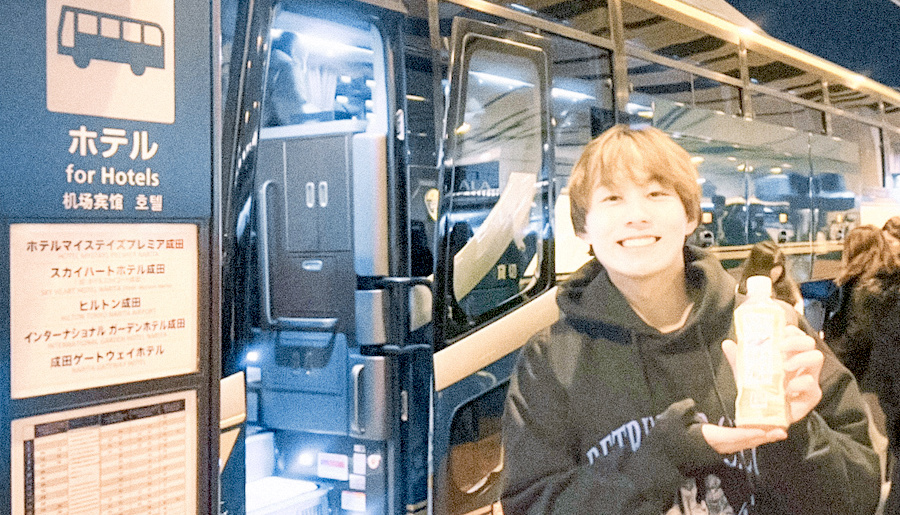
Gene Naono in Japan (Photo: Courtesy of Gene Naono)
I am extremely grateful that I was able to participate in the program, as it not only provided me a more nuanced perspective of my own identity, but it also allowed me to meet and connect with many young adults with impressive résumés and the same sentiment of wanting to develop their worldview as a Japanese American. If there are any young JAs who are interested in wanting to extend both their personal and professional network with Japan, I would wholly recommend the Kakehashi trip experience.
The trip was a relatively short one where we spent four days in Tokyo and three days in Okinawa. However, during this short duration, I have come to realize many things about Okinawa and the Japanese American identity in relation to the U.S. and Japan.
First, I want to touch on the incredible richness of Okinawa’s history and the different influences that continue to be exerted within its culture. Through my homestay experience at Uechi-san household, I learned about the dominant Chinese and Ryukyu Kingdom influences that linger today in society, now under Japanese leadership and American military influence. The Okinawa leg of the trip left such a strong impression on me that I tried by best in putting the deep complexities I felt in a simple haiku (Japanese and English versions):
リュウキュウで Land of the Shisa
日系のいしずえ Finding out identity
気づけたよ Stronger than ever
There is no place like Okinawa. Hearing the stories and history of Okinawa oddly empowered me to further try and understand my own identity. Many native Okinawans are trying their best to find their foothold in identity and culture, and I stand in solidarity with them as I believe that their effort in trying to find the fragile balance of the mixture can be shared with Nikkeijins’ sentiments in their own journey of self-realization.
Next, I want to pivot and talk about how I came out as a different person from the person I was before the trip. Prior to the trip, I knew that I wanted to dig deeper into my Japanese roots and see if there are any more connections and opportunities that I could find for self-growth.
What I did not know was that this Kakehashi project trip could pull so much out of me. From attending courtesy calls of high-ranking Japanese government officials to hearing a lecture from Glen Fukushima, a well-established Japanese American, I began to wonder why any organization would be interested in sponsoring this trip for an individual like myself.
The name of the project had the answer in itself, Kakehashi — bridging the gap. Japanese Americans can be ethnically Japanese, but we are very much so American, in the sense that we have assimilated and adopted the American way of life and thinking.
I was aware that American and Japanese philosophies differed, but this trip has helped me understand how much of a gap there is between the two. As Japanese Americans become more sparse with time, the duty to step up to the plate and become the “kakehashi” between the two countries becomes imperative for the success of both nations. The two cultures (American and Japanese) each have their own strengths and weaknesses, and it is critical that Japanese Americans are able to extract the positive aspects and foster a future that incorporates the best of both worlds.
I plan on continuing my education at UC Berkeley studying civil engineering with an emphasis on transportation engineering/planning. Visiting Japan has given me newfound appreciation for the possibilities of sophisticated transit systems here in the U.S. It is one of my ambitions to stay connected with Japanese American and Japanese organizations while I develop my career as a civil engineer.
Sophia Saito and Kyle Masukawa, Group C Participants
Participating in the Kakehashi Project was a transformative experience that exceeded all expectations. Going into this program, we were excited to travel to Japan and build deeper connections to our ancestral homeland; however, we never imagined how impactful this trip would be. Each moment truly embodied the meaning of kakehashi, “building bridges.”
Our group, Group C, traveled alongside Group B to Yamaguchi prefecture. While in Yamaguchi, our days were filled with exploration, creativity and connection. We visited the white-walled streets of Yanai, made goldfish lanterns, taste-tested shoyu ice cream at a local shoyu factory and traced our family histories at the Museum of Japanese Emigration to Hawaii.
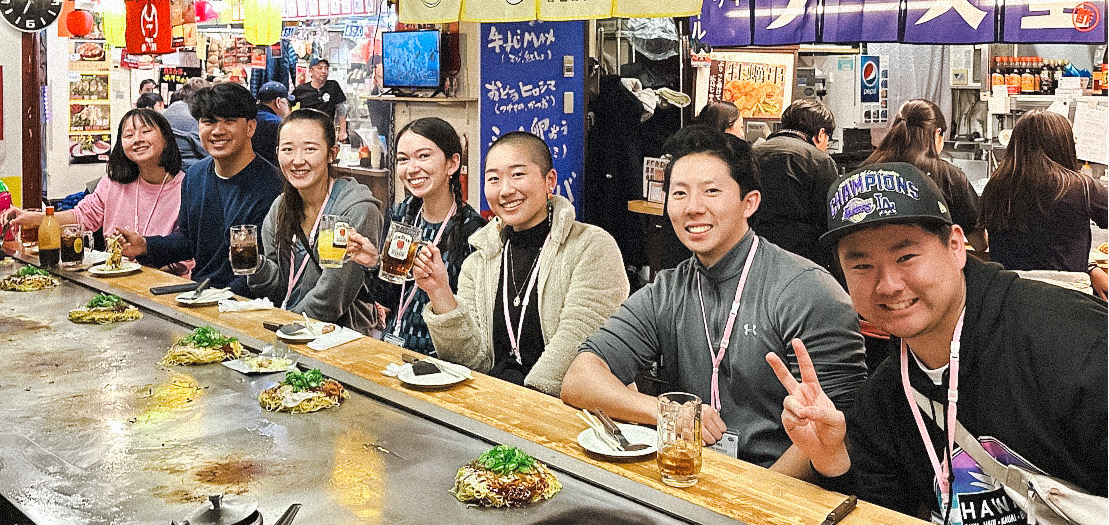
Sophia Saito (third from left) and Kyle Masukawa (far right) enjoy okonomiyaki with their fellow Kakehashi friends. (Photo: Courtesy of Sophia Saito and Kyle Masukawa)
After an activity-packed day, we arrived in Suō-Ōshima, where our host families welcomed us and immediately made us feel at home. Our homestays involved immersive experiences from mastering new recipes to teaching each other games, exploring the island and even delving into our creative sides, learning the intricate art of calligraphy and making Hina dolls from old kimonos. The homestay experience was unforgettable, providing us with insights into daily life and heightening our appreciation for Japanese culture.
It was apparent that in the few days we spent together, strong bonds were formed between participants and families. We were able to communicate through language barriers and share pieces of ourselves with one another, bridging the Suō-Ōshima and Nikkei communities together.
The final leg of our trip took place in Hiroshima, where we visited the Peace Memorial Park, the Atomic Bomb Dome and the Peace Memorial Museum. At the park, we left paper cranes as a symbol of peace before we explored the museum, which was filled with remnants of life before the bombing, images of the aftermath and art from survivors.
The museum deepened our understanding of the extensive impact the bombing had on Hiroshima and showed us that despite the hardships, the community endured, embodying the essence of gaman.
While the activities and sightseeing played a significant role in our learning and appreciation, the most impactful part of Kakehashi was the supportive community that emerged amongst the 2024 cohort. As Nikkei, our shared experiences bonded us, but even when personal experiences or feelings didn’t align with the majority, they were welcomed with curiosity, empathy and understanding.
Bus conversations, led by our amazing leader Spencer (Uemura), became a safe space for open dialogue and reflection, which can be hard to find in daily life. The varied stories shared within our group served as a powerful reminder that there is no “right” way to be Japanese American and that the beauty of the Nikkei community lies in its diversity. The community that emerged from these conversations became a huge source of support as we worked to embrace the intricacies of our own experiences. We leave this journey recognizing the multitude of ways that individuals forge connections with their heritage and navigate their identities.
While it is difficult to articulate the profound effect this program has had on each of us, the memories that we made, the sites that we saw, the stories that we heard and the community we built all undoubtedly shaped our perspectives and are invaluable experiences that we will carry with us for the rest of our lives.
Part II of Kakehashi reflections will be featured in the Pacific Citizen’s next issue.

